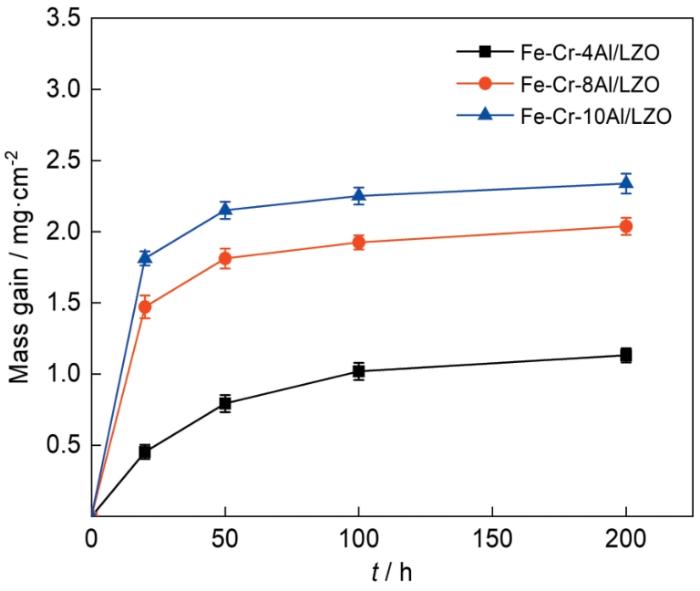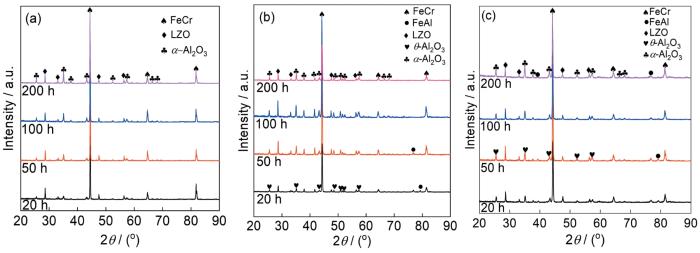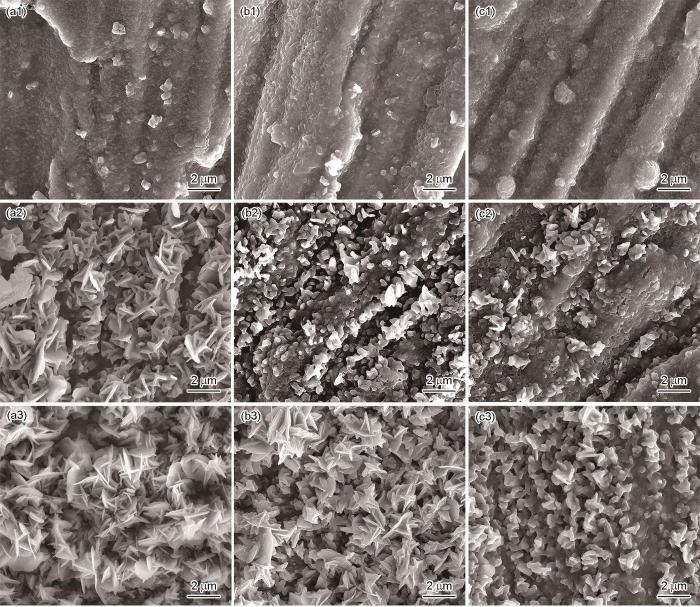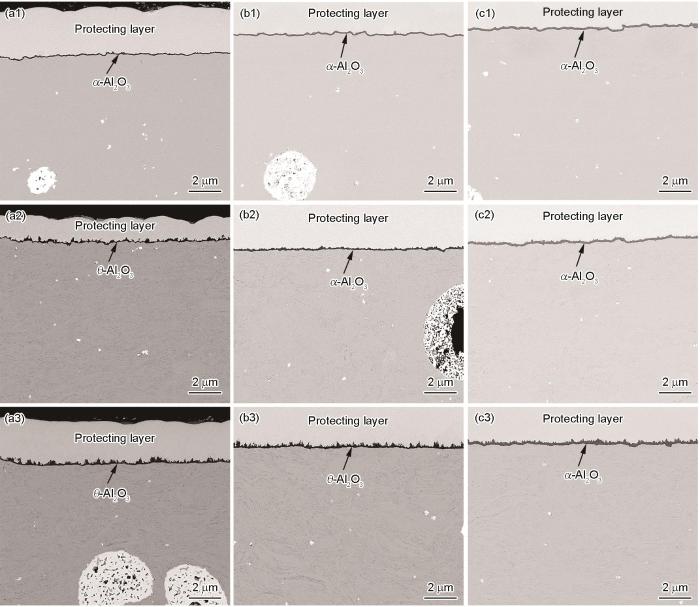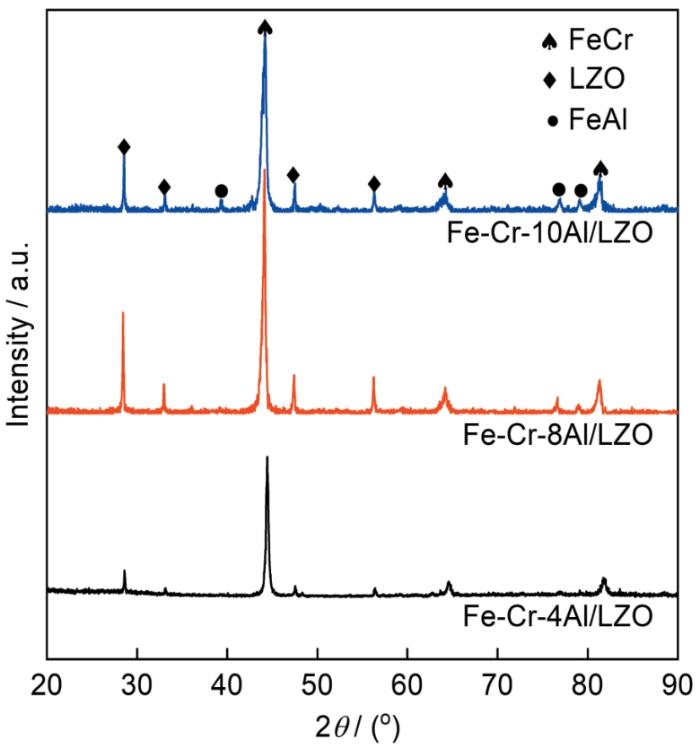随着我国国民经济和国防工业的快速发展,广泛应用于石油化工、航空航天、武器装备等方面的无缝钢管的需求量越来越大,质量要求也越来越高。然而无缝钢管内径成型的最核心部件穿孔顶头的失效成为制约高质量高尺寸精度无缝钢管产业发展的瓶颈难题。
陶瓷颗粒增强金属基复合材料兼具二者优点,采用适当的该类复合材料制备穿孔顶头是解决以上难题的有效途径。FeCrAl具有优异的抗高温氧化性能,甚至在1100℃以上的高温和水蒸气环境下仍能保持优异的高温强度和抗氧化等性能,最主要原因是其在服役过程中表面可生成一层连续致密稳定且硬度高耐磨性好的α-Al2O3膜,抑制元素的扩散速率[8~20]。La2Zr2O7(简写为LZO)具有优异的高温相结构稳定性(超过1300℃时相结构仍然保持稳定)、低热导率(1.56 W/(m·K))、高熔点(2300℃)等优良性能[21~25]。将LZO颗粒弥散分布于FeCrAl中而制备成的FeCrAl/LZO复合材料兼具二者优点,可以有效解决上述难题。该复合材料可大幅提高穿孔顶头服役寿命,且其成本较低,适合批量生产,具有明显优势。FeCrAl中适当Al含量可使高温氧化过程中材料表面产生连续致密高硬度耐磨α-Al2O3膜,起到良好抗氧化和耐磨作用;高温稳定性优异的LZO颗粒弥散分布在FeCrAl中将显著提高穿孔顶头高温强度和耐磨性能,且LZO的低热导率可保证复合材料具有较低的综合热导率,进一步提高穿孔顶头寿命。因此深入研究FeCrAl/LZO复合材料组织结构尤其是含Al量对其高温氧化行为的影响对于发展长寿命高可靠无缝钢管穿孔顶头具有重要意义,但目前该方面应用研究未见报道。
本研究采用机械合金化(MA)+放电等离子烧结(SPS)技术制备了Fe-Cr-xAl/LZO(x = 4、8和10,质量分数,%,下同)复合材料,阐明复合材料中Al含量对其高温氧化行为影响规律,为发展长寿命无缝钢管穿孔顶头奠定一定基础。
1 实验方法
本实验原始粉末采用FeCrAl球形合金粉末(Fe 74%、Cr 22%、Al 4%,质量分数)、Al近球形粉(>99.999%,质量分数)和LZO空心球形粉末(>99.999,质量分数),其平均粒径分别为10.9 ± 7.2 μm、9.3 ± 4.6 μm和54.6 ± 15.8 μm。
首先,分别按照一定比例将原始FeCrAl合金粉末和Al粉混合后在YXQM-4L行星式球磨机中进行机械合金化处理(转速300 r/min,球磨时间10 h,球料质量比15∶1,加入2 mL C2H5OH作为球磨过程控制剂,用纯度>99.999% (体积分数)的高纯氩气保护制备出Al含量分别为8%和10%的新FeCrAl合金粉末。然后,取FeCrAl合金粉末(原始FeCrAl合金粉末或球磨态新FeCrAl合金粉末)和一定比例LZO粉末混合均匀(体积比为9∶1)。最后,将上述FeCrAl与LZO的混合粉末置于内径ϕ30 mm石墨模具内,采用SPS装置在真空气氛下进行烧结(烧结温度1100℃,压强20 MPa,700℃之前升温速率100℃/min,700℃之后升温速率50℃/min,保温时间10 min,真空度<10 Pa),制备出直径为30 mm、高度为10 mm的Fe-Cr-xAl/LZO复合材料。
将烧结态试样在1000℃静态空气中进行恒温氧化实验,实验过程中分别在氧化20、50、100及200 h时各取出3个试样,测量其单位面积质量变化并取平均值及标准偏差,获得复合材料高温氧化动力学曲线,进行氧化动力学分析;利用D8 Advance-A25型X射线衍射仪(XRD)对样品物相进行测定;利用配有能谱仪(EDS)的D8ADVNCE-A25扫描电子显微镜(SEM)观察和分析样品组织结构及化学成分。
2 结果与讨论
2.1 氧化动力学
图1为Fe-Cr-xAl/LZO复合材料在1000℃空气中的氧化增重动力学曲线。由图可知,3种复合材料氧化动力学曲线变化趋势基本一致,即氧化初期(前20 h)氧化速率较快,随着氧化时间延长氧化速率逐渐趋缓和稳定(100~200 h),氧化动力学近似呈抛物线规律。对比3种复合材料氧化动力学曲线可知,氧化初期复合材料的氧化速率随着其中Al含量的增高而逐渐增大,而氧化稳定阶段3种复合材料氧化速率相差不大。为了揭示含Al量对MA+SPS FeCrAl/LZO复合材料氧化速率的影响规律,接下来对其表面氧化膜组织结构进行深入分析。
图1
图1
Fe-Cr-xAl/LZO复合材料在1000℃空气中氧化动力学曲线
Fig.1
Oxidation kinetics of three as-prepared composites at 1000oC in air
2.2 氧化物XRD图谱
图2为Fe-Cr-xAl/LZO复合材料在1000℃空气中氧化不同时间的XRD图谱。由图可知,3种复合材料高温氧化产物均主要为Al2O3,但其种类有所区别:Fe-Cr-4Al/LZO复合材料氧化过程中氧化产物保持为稳定的α-Al2O3;Fe-Cr-8Al/LZO和Fe-Cr-10Al/LZO复合材料氧化初期氧化产物主要为亚稳的θ-Al2O3,随后逐渐转变为稳定的α-Al2O3;Fe-Cr-10Al/LZO复合材料表面的θ-Al2O3比Fe-Cr-8Al/LZO复合材料的保持时间更长。由于与α-Al2O3相比,θ-Al2O3具有较高的生长速率,所以氧化初期Fe-Cr-4Al/LZO复合材料氧化速率最低,而Fe-Cr-10Al/LZO复合材料具有最高的氧化速率。3种复合材料氧化稳定阶段氧化速率相当主要是由于此时其表面氧化物均为α-Al2O3,生长行为接近。
图2
图2
Fe-Cr-xAl/LZO复合材料高温氧化不同时间XRD图谱
Fig.2
XRD patterns of Fe-Cr-4Al/LZO (a), Fe-Cr-8Al/LZO (b) and Fe-Cr-10Al/LZO (c) composites oxidized at 1000oC for different time
2.3 氧化膜组织结构
分析复合材料表面氧化膜显微结构有助于进一步阐明复合材料中含Al量对其氧化动力学规律的影响。图3分别为Fe-Cr-xAl/LZO复合材料在1000℃空气中氧化不同时间的表面形貌。由图并结合XRD结果可知,3种复合材料表面氧化膜均未见明显开裂;Fe-Cr-4Al/LZO复合材料氧化过程中表面氧化膜保持平滑形貌特征,为典型的α-Al2O3形貌;而Fe-Cr-8Al/LZO和Fe-Cr-10Al/LZO复合材料在氧化初期表面呈现θ-Al2O3的“针状或片状”形貌且随着氧化时间延长逐渐演变为相对平滑的α-Al2O3形貌,且Fe-Cr-10Al/LZO复合材料表面θ-Al2O3形貌保持时间较长,与上述XRD结果吻合较好。
图3
图3
Fe-Cr-xAl/LZO复合材料1000℃空气中氧化不同时间后的表面形貌
Fig.3
Surface morphologies of Fe-Cr-4Al/LZO (a), Fe-Cr-8Al/LZO (b) and Fe-Cr-10Al/LZO (c) composites oxidized in air at 1000oC for 20 h (a1-c1), 50 h (a2-c2) and 200 h (a3-c3)
图4分别为Fe-Cr-xAl/LZO复合材料高温氧化不同时间截面显微结构。由图并结合以上分析可知,3种复合材料高温氧化过程中表面均生成了连续的Al2O3膜并保持到200 h未发生明显开裂;Fe-Cr-4Al/LZO复合材料氧化过程中表面保持为连续均匀平滑缓慢生长的α-Al2O3膜,Fe-Cr-8Al/LZO和Fe-Cr-10Al/LZO复合材料在氧化初期其表面为“针状或片状”且生长较快的亚稳θ-Al2O3膜,随着氧化时间的延长,θ-Al2O3逐渐转变为相对平滑的α-Al2O3膜,且Fe-Cr-10Al/LZO复合材料表面θ-Al2O3膜特征保持时间较长,进而影响复合材料表面氧化膜生长速率。综上可知,3种复合材料表面氧化膜截面结构与其表面和XRD结果吻合较好。
图4
图4
Fe-Cr-xAl/LZO复合材料1000℃空气中氧化不同时间后截面显微结构
Fig.4
Cross-sectional microstructures of Fe-Cr-4Al/LZO (a), Fe-Cr-8Al/LZO (b) and Fe-Cr-10Al/LZO (c) composites oxidized in air at 1000oC for 20 h (a1-c1), 50 h (a2-c2) and 200 h (a3-c3)
2.4 烧结态复合材料组织结构
为了进一步揭示Fe-Cr-xAl/LZO复合材料中含Al量对其表面Al2O3膜生长行为的影响,接下来将对烧结态复合材料组织结构进行深入分析。图5为烧结态Fe-Cr-xAl/LZO复合材料XRD图谱。由图可知,烧结态的Fe-Cr-4Al/LZO复合材料主要由FeCr固溶体(Al固溶于其中)和LZO两相组成,而Fe-Cr-8Al/LZO和Fe-Cr-10Al/LZO复合材料均主要由FeCr固溶体、FeAl金属间化合物和LZO 3相组成,且3种复合材料中均未发现明显内氧化物。
图5
图5
烧结态Fe-Cr-xAl/LZO复合材料XRD图谱
Fig.5
XRD patterns of Fe-Cr-xAl/LZO (x = 4, 8 and 10) composites after sintering
烧结态Fe-Cr-xAl/LZO复合材料的截面显微形貌如图6所示。由图可知,3种复合材料具有均匀致密的组织结构(孔隙率均约为0.7%且孔隙主要为LZO颗粒的空心),且LZO颗粒基本保持原始空心球形形貌特征,LZO颗粒与FeCrAl合金界面结合良好;3种复合材料的相组成与XRD结果(图5)保持一致。经EDS分析可知图6b,c合金基质中的深色相主要由Fe和Al组成,结合图5结果可知,该深色相即为FeAl金属间化合物;Fe-Cr-10Al/LZO复合材料中的FeAl金属间化合物含量明显比Fe-Cr-8Al/LZO中的高。由此结合图4b,c可知,Fe-Cr-8Al/LZO和Fe-Cr-10Al/LZO复合材料在高温氧化过程中,合金基质中的深色相即为FeAl金属间化合物;随着氧化时间的延长,FeAl相因Al扩散至复合材料表面被氧化消耗,而使其含量逐渐降低;氧化过程中,Fe-Cr-10Al/LZO中的FeAl含量均比Fe-Cr-8Al/LZO的高。
图6
图6
烧结态Fe-Cr-xAl/LZO复合材料截面形貌
Fig.6
Cross-sectional morphologies of Fe-Cr-4Al/LZO (a), Fe-Cr-8Al/LZO (b) and Fe-Cr-10Al/LZO (c) composites after sintering
3 结论
(1) 氧化初期,MA+SPS FeCrAl/LZO复合材料的氧化速率随着其中Al含量的升高而逐渐增大,而氧化稳定阶段3种复合材料氧化速率相差不大。
(2) 含Al量对复合材料及其表面氧化膜组织结构有显著影响。Fe-Cr-4Al/LZO复合材料主要由FeCr固溶体(Al固溶于其中)和LZO两相组成,而Fe-Cr-8Al/LZO和Fe-Cr-10Al/LZO复合材料均主要由FeCr固溶体、FeAl金属间化合物和LZO 3相组成。Fe-Cr-4Al/LZO复合材料高温氧化过程中表面保持为生长较慢的α-Al2O3膜;Fe-Cr-8Al/LZO和Fe-Cr-10Al/LZO复合材料氧化初期氧化产物主要为亚稳的θ-Al2O3,随后逐渐转变为稳定的α-Al2O3;Fe-Cr-10Al/LZO复合材料表面的θ-Al2O3比Fe-Cr-10Al/LZO复合材料保持时间长。
(3)含Al量对复合材料氧化速率有显著影响。由于θ-Al2O3生长速率比α-Al2O3高,所以氧化初期Fe-Cr-4Al/LZO复合材料氧化速率最低,而Fe-Cr-10Al/LZO复合材料具有最高的氧化速率。氧化稳定阶段3种复合材料的氧化速率相当主要是由于此时其表面氧化物均为α-Al2O3,生长行为接近。
参考文献
Experiments and simulation on Mannesmann piercing process in the drill steel manufacture
[J].
New rotary piercing process for an AZ31 magnesium alloy seamless tube
[J].
Investigation of failure of 15Cr2Ni3MoW steel piercing plug and modification
[J].
15Cr2Ni3MoW钢穿孔顶头的失效分析及改进
[J].
Status quo on research of failure forms and improving measures of piercing plug
[J].
穿孔顶头失效形式及改进措施研究的现状
[J].
Physical properties of iron-oxide scales on Si-containing steels at high temperature
[J].
Progress of research on seamless steel tube piercing plug
[J].
无缝钢管穿孔顶头的研究进展
[J].
Research progress on the preparation technology of molybdenum alloy piercing plug
[J].
钼合金顶头制备技术研究进展
[J].钼合金顶头是生产不锈钢等高合金含量无缝钢管的关键工具之一。从钼合金顶头的化学成分、掺杂工艺、粉体粒度和烧结工艺等方面入手,研究影响顶头力学性能和使用寿命的主要因素。分析了不同合金元素及添加方式对合金强韧化机理的影响,讨论了粉体掺杂工艺、粉体粒度分布及控制对于后续制备过程中获得致密、均一组织的影响,对比了传统烧结工艺、活化烧结技术和新型烧结技术的优缺点,并为今后烧结成形工艺的研究提供了一些新思路。
Glass-like thermal conductivities in (La1- x1Y x1)2(Zr1- x2Y x2)2O7- x2 (x = x1 + x2, 0 ≤ x ≤ 1.0) solid solutions
[J].
Current thoughts on reactive element effects in alumina-forming systems: in memory of John Stringer
[J].
Spallation behaviour of alumina scale formed on FeCrAlY alloy after isothermal oxidation
[J].
Optimization of reactive-element additions to improve oxidation performance of alumina-forming alloys
[J].
A study of the oxidation of FeCrAl alloy in pressurized water and high-temperature steam environment
[J].
Characterisation of Fe-20Cr-6Al-Y model alloy in supercritical water
[J].
Effect of steam on high temperature oxidation behaviour of alumina-forming alloys
[J].
Microstructure of FeCrAl thin film composed of nanocrystals deposited on Zr alloy and their corrosion behavior under water steam atmosphere
[J].Zr alloy cladding materials is the core component of the nuclear reactor, the safety of cladding materials is very important. Zr alloy cladding materials is inclined to react with water under high temperature. The products are ZrO₂ and H₂. The mechanical property of Zr alloy decreases promptly. In order to protect Zr alloy from high temperature water, FeCrAl thin film layer was deposited on Zr alloy surface. The structure, chemical composition, surface elemental valence and morphology of FeCrAl thin film layer were carefully investigated by XRD, EDS, XPS, and SEM. After the test of corrosion experiment, deposition of FeCrAl thin film layer on Zr alloy surface showed the better corrosion property than Zr alloy under high temperature water steam atmosphere. The corrosion rate of Zr alloy with deposited FeCrAl thin film was 1.5 times lower than that of Zr alloy. The deposition of FeCrAl thin film layer on Zr alloy is an efficient approach to improve the corrosion property.
Oxidation kinetics of Y-doped FeCrAl-alloys in low and high pO2 gases
[J].
Growth rates of alumina scales on Fe-Cr-Al alloys
[J].
Oxidation behavior of FeCrAl coated Zry-4 under high temperature steam environment
[J].
Exploring the high-temperature steam oxidation behaviors of the lean-Cr (7~10 wt%) FeCrAl alloys
[J].
High-temperature steam oxidation behavior of alumina-forming duplex FeNiCrAl and ferritic FeCrAl alloys at 800oC to 1050oC
[J].
Prolong the durability of La2Zr2O7/YSZ TBCs by decreasing the cracking driving force in ceramic coatings
[J].
Thermal and mechanical properties of crack-designed thick lanthanum zirconate coatings
[J].
Investigation of a new type of composite ceramics for thermal barrier coatings
[J].
Thermal barrier coatings with Al2o3-Pt composite bond-coat and La2Zr2O7-Pt top-coat prepared by cathode plasma electrolytic deposition
[J].
Novel ceramic materials for thermal barrier coatings
[J].
新型热障涂层陶瓷隔热层材料
[J].热障涂层(thermal barrier coatings, TBCs)是先进燃气涡轮发动机核心热端部件高压涡轮叶片的关键技术,已经在航空发动机和地面燃气轮机上获得成功应用的热障涂层陶瓷隔热层材料为氧化钇部分稳定氧化锆(YSZ)。由于受高温稳定性、隔热性能等的局限,YSZ已不能满足下一代航空发动机的发展要求。本文介绍了近年来国内外在多元氧化物掺杂氧化锆、A<sub>2</sub>B<sub>2</sub>O<sub>7</sub>型烧绿石或萤石化合物、磁铅石型六铝酸盐化合物、石榴石型化合物、钙钛矿结构化合物和其他新型氧化物陶瓷等先进超高温热障涂层陶瓷材料方面的研究进展,并展望了今后超高温热障涂层陶瓷材料所面临的挑战和发展动向。
Effect of Al mass fraction on the properties of porous FeCrAl alloys
[J].
铝质量分数对FeCrAl合金多孔材料性能的影响
[J].
Accelerating formation of nanocrystallite Al-coatings by ball peening process
[D].
喷丸加速制备纳米结构铝化物涂层的研究
[D].
The development of research progress on oxidation of iron aluminides intermetallics at high temperature
[J].
FeAl系合金抗高温氧化性能研究进展
[J].
Contribution of Si to the precipitation of γ'-phase in high Al content IN718 coatings and the phase transformation of α-Al2O3 during high temperature oxidation
[J].




